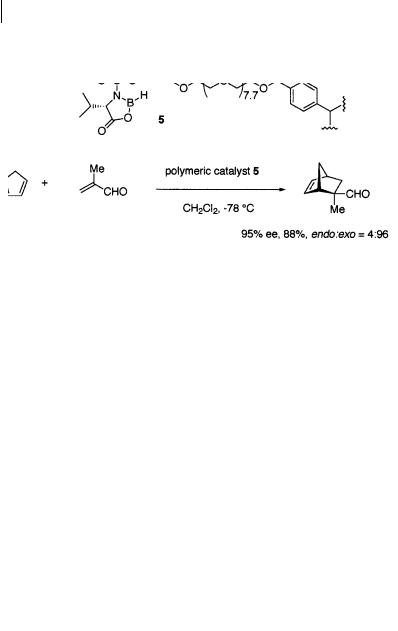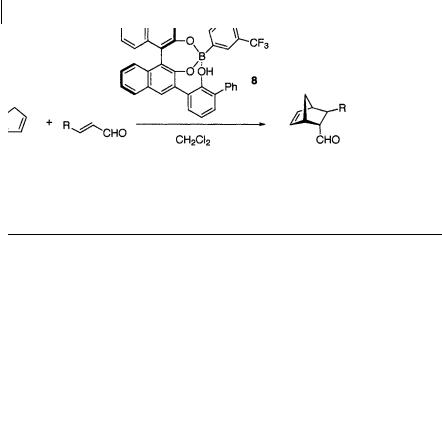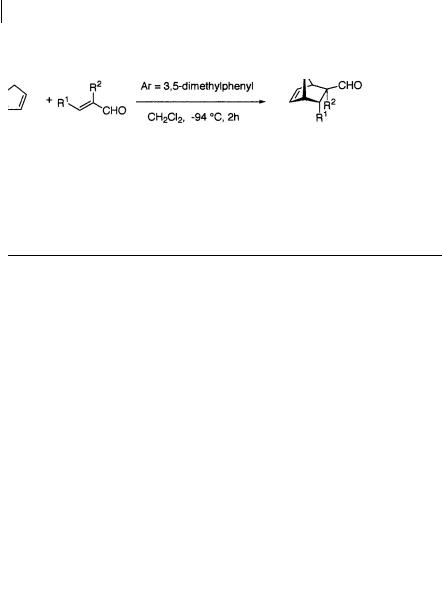
Cycloaddition Reactions in Organic Synthesis
.pdf
1.2 The Chiral Lewis Acid-catalyzed Diels-Alder Reaction 7
Scheme 1.2
rane-THF complex with the generation of H2. The boron atom of the (acyloxy)borane is activated by the electron-withdrawing acyloxy group (Scheme 1.3).
Scheme 1.3
The chiral (acyloxy)borane (CAB) catalyst 3 is a practical catalyst, because it is applicable to the reaction of a variety of dienes and aldehydes giving high enantioselectivity (Scheme 1.4, 1.5, Table 1.1, 1.2). The reaction has generality, working not only for reactive cyclopentadiene, but also for less reactive dienes like isoprene. There are several noteworthy features. An -substituent on the dienophile increases enantioselectivity (acrolein relative to methacrolein), whereas -substitu- tion dramatically reduces it (crotonaldehyde). When the substrate has substituents at both - and -positions, high enantioselectivity is observed. In a series of investigations using several kinds of tartaric acid derivative, it was found that the boron atom can form a five-membered ring structure with an -hydroxy acid moiety of the tartaric acid, and that the remaining carboxyl group may not bond to the boron atom.
One interesting phenomenon was the effect of the boron substituent on enantioselectivity. The stereochemistry of the reaction of -substituted , -unsatu- rated aldehydes was completely independent of the steric features of the boron substituents, probably because of a preference for the s-trans conformation in the transition state in all cases. On the other hand, the stereochemistry of the reaction of cyclopentadiene with -unsubstituted , -unsaturated aldehydes was dramatically reversed on altering the structure of the boron substituents, because the stable conformation changed from s-cis to s-trans, resulting in production of the opposite enantiomer. It should be noted that selective cycloadditions of -unsubsti- tuted , -unsaturated aldehydes are rarer than those of -substituted , -unsatu-

81 Catalytic Asymmetric Diels-Alder Reactions
rated aldehydes, because it is difficult to control the s-cis/s-trans conformation ratio of the former in the transition state, whereas for the latter the s-trans conformation predominates. These results indicate that control of the s-cis/s-trans conformation of the former aldehydes can be achieved by means of the catalyst.
Scheme 1.4 |
|
|
|
|
|
Table 1.1 |
Asymmetric |
Diels-Alder |
reactions of cyclopentadiene |
catalyzed by CAB catalyst 3 |
|
[5 a, b] |
|
|
|
|
|
|
|
|
|
|
|
R1 |
R2 |
Time (h) |
Yield (%) |
endo/exo |
ee (%) |
|
|
|
|
|
|
H |
Me |
6 |
85 |
11:89 |
96 |
H |
H |
14.5 |
90 |
88:12 |
84 |
Me |
H |
10 |
53 |
90:10 |
2 |
Me |
Me |
9.5 |
91 |
3:97 |
90 |
H |
Br |
10 |
100 |
6:94 |
95 |
Me |
Br |
12 |
100 |
>1 : 99 |
98 |
|
|
|
|
|
|
Scheme 1.5
Table 1.2 |
Asymmetric Diels-Alder reactions catalyzed by CAB catalyst 3 [5 a, b] |
|||||
|
|
|
|
|
|
|
R1 |
R2 |
R3 |
Temp. ( C) |
Time (h) |
Yield (%) |
ee (%) |
|
|
|
|
|
|
|
Me |
Me |
Me |
–78 |
7.5 |
61 |
97 |
Me |
H |
Me |
–40 |
10.5 |
65 |
91 |
Me |
Me |
H |
–78 |
10.5 |
53 |
84 |
Me |
Me |
Br |
–78 |
46 |
80 |
95 |
Me |
H |
Br |
–40 |
12 |
52 |
87 |
|
|
|
|
|
|
|
A detailed 1H NMR study and determination of the X-ray structure of the ligand has suggested the occurrence of -stacking of the 2,6-diisopropoxybenzene ring and coordinated aldehyde [5 c]. Because of this stacking, the si face of the CAB-co- ordinated , -unsaturated aldehyde is sterically shielded (Fig. 1.1).

1.2 The Chiral Lewis Acid-catalyzed Diels-Alder Reaction 9
Fig. 1.1 CAB catalyst 3 and methacrolein
The intramolecular Diels-Alder reaction of 2-methyl-(E,E)-2,7,9-decatrienal catalyzed by the CBA catalyst 3 proceeds with the same high diastereoand enantioselectivity [5d] (Scheme 1.6).
Scheme 1.6
A tryptophan-derived oxazaborolidine 4 was prepared by Corey et al. from a tryptophan derivative and BuB(OH)2 with elimination of water [6]. In the first use of - bromoacrolein in the catalytic asymmetric Diels-Alder reaction, Corey et al. applied this catalyst to -bromoacrolein, a reaction which is outstandingly useful, because of the exceptional synthetic versatility of the resulting cycloadducts. Corey et al. have shown that the adduct of -bromoacrolein and benzyloxymethylcyclopentadiene obtained in high optical purity can be transformed into an important intermediate for the synthesis of prostaglandins [6 a] (Scheme 1.7, 1.8). Since this publication the Diels-Alder reaction of -bromoacrolein and cyclopentadiene has come to be regarded as a test reaction of the effectiveness of newly developed chiral Lewis acids. Other applications of this asymmetric Diels-Alder reaction to natural product synthesis are shown in Schemes 1.7–1.11 [6 c]. The Diels-Alder reaction of an elaborated triisopropoxydiene and methacrolein catalyzed by the modified borane reagent affords in high optical purity a chiral cyclohexane skeleton, which was successfully transformed to cassinol (Scheme 1.9). The chiral Diels-Al- der adduct obtained in high optical purity (99% ee) from 2-(2-bromoallyl)-1,3-cy- clopentadiene and -bromoacrolein was converted to a key intermediate in the synthesis of the plant growth regulator gibberellic acid (Scheme 1.10).
The structure of the complex of (S)-tryptophan-derived oxazaborolidine 4 and methacrolein has been investigated in detail by use of 1H, 11B and 13C NMR [6b]. The proximity of the coordinated aldehyde and indole subunit in the complex is suggested by the appearance of a bright orange color at 210 K, caused by formation of a charge-transfer complex between the -donor indole ring and the acceptor aldehyde. The intermediate is thought to be as shown in Fig. 1.2, in which the s-cis conformer is the reactive one.

10 1 Catalytic Asymmetric Diels-Alder Reactions
Scheme 1.7
Scheme 1.8
|
|
TIPSO |
|
TIPSO |
|||
|
|
||
|
|
|
Scheme 1.9
The borane catalyst 4 is also effective in the Diels-Alder reaction of furan (Scheme 1.11). In the presence of a catalytic amount of this reagent -bromoacro- lein or -chloroacrolein reacts with furan to give the cycloadduct in very good chemical yield with high optical purity [6 d].
The polymer-supported chiral oxazaborolidinone catalyst 5 prepared from valine was found by Ituno and coworkers to be a practical catalyst of the asymmetric Diels-Alder reaction [7] (Scheme 1.12). Of the several cross-linked polymers with a

1.2 The Chiral Lewis Acid-catalyzed Diels-Alder Reaction 11
Scheme 1.10
Scheme 1.11
chiral N-sulfonylamino acid moiety examined, the polymeric catalyst containing a relatively long oxyethylene chain cross-linkage gave higher enantioselectivity than those with flexible alkylene chain cross-linkages or with shorter oxyethylene chain cross-linkages. An interesting feature is that this polymeric chiral catalyst is more enantioselective than its low-molecular-weight counterpart. One of the great synthetic advantages of this reaction is that catalyst 5 can be easily recovered from
Fig. 1.2 Oxazaborolidine 4 and -bromoacrolein

12 1 Catalytic Asymmetric Diels-Alder Reactions
the products and re-used. The reaction can be performed in a flow system, which avoids destruction of the polymeric beads by vigorous stirring.
Scheme 1.12
Kobayashi and Mukaiyama developed a zwitterionic, proline-based Lewis acid 6 by mixing aminoalcohol and BBr3 [8] (Scheme 1.13). The structure of the catalyst was determined by 11B, 1H, and 13C NMR analysis [9]. The HBr salt is important for achieving high enantioselectivity – the catalyst prepared from the sodium salt of the aminoalcohol and BBr3 (HBr-free condition) is ineffective, whereas the adduct was produced with high enantioselectivity when the catalyst prepared by reaction of aminoalcohol, NaH, BBr3, and HBr gas was used. This catalyst promotes the DielsAlder reaction of methacrolein and cyclopentadiene with high enantioselectivity.
Scheme 1.13
In 1994 Yamamoto et al. developed a novel catalyst which they termed a “Brønsted acid-assisted chiral Lewis acid” (BLA) [10] (Scheme 1.14, Table 1.3). The catalyst 7 was prepared from (R)-3,3 -dihydroxyphenyl)-2,2 -dihydroxy-1,1 -binaphthyl by reaction with B(OMe)3 and removal of methanol [10 a, d]. The Brønsted acid is essential for both the high reactivity of the Lewis acid and the high enantioselectivity – the

1.2 The Chiral Lewis Acid-catalyzed Diels-Alder Reaction 13
borane catalyst prepared from the monobenzyl ether or monosilyl ether of the parent ligand afforded cycloadducts in only low chemical and optical yields. Although catalyst 7 is one of the best for the enantioand exo-selective Diels-Alder reaction of -substituted a, -unsaturated aldehydes with highly reactive dienes such as cyclopentadiene, enantioselectivity is low for the corresponding reaction of -unsub- stituted a, -unsaturated aldehydes such as acrolein and crotonaldehyde.
Scheme 1.14
Table 1.3 Asymmetric Diels-Alder reactions of -substituted aldehydes catalyzed by 7 [10 a, d]
R1 |
R2 |
Yield (%) |
endo/exo |
ee (%) |
|
|
|
|
|
H |
Br |
>99 |
>1 : 99 |
99 |
H |
Me |
>99 |
>1 : 99 |
99 |
H |
Et |
>99 |
3 : 97 |
92 |
Me |
Me |
>99 |
>1 : 99 |
98 |
|
–(CH2)3– |
>99 |
2 : 98 |
93 |
|
|
|
|
|
To overcome these problems with the first generation Brønsted acid-assisted chiral Lewis acid 7, Yamamoto and coworkers developed in 1996 a second-generation catalyst 8 containing the 3,5-bis-(trifluoromethyl)phenylboronic acid moiety [10 b, d] (Scheme 1.15, 1.16, Table 1.4, 1.5). The catalyst was prepared from a chiral triol containing a chiral binaphthol moiety and 3,5-bis-(trifluoromethyl)phenylboronic acid, with removal of water. This is a practical Diels-Alder catalyst, effective in catalyzing the reaction not only of -substituted a, -unsaturated aldehydes, but also of -unsubstituted a, -unsaturated aldehydes. In each reaction, the adducts were formed in high yields and with excellent enantioselectivity. It also promotes the reaction with less reactive dienophiles such as crotonaldehyde. Less reactive dienes such as isoprene and cyclohexadiene can, moreover, also be successfully employed in reactions with bromoacrolein, methacrolein, and acrolein dienophiles. The chiral ligand was readily recovered (>90%).

14 1 Catalytic Asymmetric Diels-Alder Reactions
Scheme 1.15
Table 1.4 Asymmetric Diels-Alder reactions of -unsubstituted aldehydes catalyzed by 8 [10 b, d]
R |
Temp. ( C) |
Yield (%) |
endo/exo |
ee (%) |
|
|
|
|
|
|
|
H |
–78 |
84 |
97 |
: 3 |
95 |
Me |
–78 |
94 |
90 |
: 10 |
95 |
Et |
–78 |
73 |
91 |
: 9 |
98 |
Ph |
–40 |
94 |
74 |
: 26 |
80 |
CO2Et |
–78 |
91 |
98 |
: 2 |
95 |
|
|
|
|
|
|
Scheme 1.16
Table 1.5 |
Asymmetric Diels-Alder reactions catalyzed by 8 [10 d] |
|||
|
|
|
|
|
R1 |
R2 |
R3 |
Yield (%) |
ee (%) |
Me |
H |
Br |
95 |
>99 |
Me |
Me |
Br |
95 |
91 |
Me |
H |
Me |
73 |
>99 |
Me |
H |
H |
95 |
99 |
Me |
Me |
H |
97 |
>99 |
|
|
|
|
|
Brønsted acid-assisted chiral Lewis acid 8 was also applied to the intramolecular Diels-Alder reaction of an -unsubstituted triene derivative. (E,E)-2,7,9-Decatrienal reacts in the presence of 30 mol% of the catalyst to afford the bicyclo compound in high yield and good enantioselectivity [10d] (Scheme 1.17).

1.2 The Chiral Lewis Acid-catalyzed Diels-Alder Reaction 15
Scheme 1.17
Another application of catalyst 8 is to the reaction of acetylenic aldehydes [10c] (Scheme 1.18, Table 1.6). Two acetylenic dienophiles have been reacted with cyclopentadiene or cyclohexadiene to give bicyclo[2.2.1]heptadiene or bicyclo[2.2.2]octadiene derivatives in high optical purity. A theoretical study suggests that this reaction proceeds via an exo transition state.
Scheme 1.18
Table 1.6 |
Asymmetric Diels-Alder reactions of alkynyl aldehydes catalyzed by 8 [10 c] |
||
|
|
|
|
R |
n |
Yield (%) |
ee (%) |
|
|
|
|
H |
1 |
63 |
88 |
CO2Et |
1 |
97 |
95 |
CO2Et |
2 |
81 |
84 |
I |
1 |
72 |
85 |
|
|
|
|
For many of these asymmetric Diels-Alder reactions, there are major limitations with regard to the range of dienes to which they can be applied successfully. In most asymmetric catalytic Diels-Alder reactions with a, -unsaturated aldehydes as dienophiles, reactive dienes such as cyclopentadiene have been employed, and 1,3- butadiene and 1,3-cyclohexadiene have not been used successfully. To expand the scope and utility of the catalytic enantioselective Diels-Alder reaction, Corey and coworkers have developed a new class of super-reactive chiral Lewis acid catalyst [11] (Scheme 1.19, 1,20, Table 1.7). Cationic oxazaborinane catalyst 9 was prepared from aminosilyl ether and BBr3. As the same high enantioselectivity was obtained with a molar ratio of BBr3 to aminosilyl ether between 0.9:1 and 1.6:1, the cationic form of 9 (paired with the BBr–4 counter-ion) is thought to be generated. A much more active Lewis acid catalyst was generated on addition of Ag+B[C6H3- 3,5-(CF3)2]–4 to the above catalyst; this afforded the super-reactive catalyst with the B[C6H3-3,5-(CF3)2]–4 counter-ion. In the presence of this catalyst -substituted a, - unsaturated aldehydes react not only with reactive cyclopentadiene, but also 1,3-

16 1 Catalytic Asymmetric Diels-Alder Reactions
butadiene and 1,3-cyclohexadiene at low temperature (–94 C), in short reaction times (<2 h), to afford cycloadducts with high exo and enantioselectivity.
Scheme 1.19
Table 1.7 Asymmetric Diels-Alder reactions catalyzed by super Lewis acid 9 [11]
R1 |
R2 |
X |
Yield (%) |
endo/exo |
ee (%) |
|
H |
Br |
B[C6H3-3,5-(CF3)2]4 |
99 |
9 |
: 91 |
98 |
H |
Br |
Br or BBr4 |
99 |
6 |
: 94 |
95 |
H |
Me |
B[C6H3-35-(CIF3)2]4 |
98 |
11 |
: 89 |
87 |
H |
Me |
Br or BBr4 |
99 |
12 |
: 82 |
90 |
Me |
Br |
B[C6H3-3,5-(CF3)2]4 |
99 |
>2 : 98 |
96 |
|
Me |
Me |
Br or BBr4 |
88 |
>2 : 98 |
89 |
|
–(CH2)4– |
|
Br or BBr4 |
99 |
>2 : 98 |
96 |
|
|
|
|
|
|
|
|
Scheme 1.20
This catalyst was successfully applied to the Diels-Alder reaction of propargyl aldehydes as dienophiles [12] (Scheme 1.21, Table 1.8). Though 2-butyn-1-al and 2-oc- tyn-1-al are unreactive dienophiles, silyland stannyl-substituted a, -acetylenic aldehydes react with cyclopentadiene readily in the presence of 20 mol% of the catalyst at low temperature to give bicyclo[2.2.1]heptadiene derivatives in high optical purity; these derivatives are synthetically useful chiral building blocks.
The two 3,5-dimethylbenzyl substituents on the nitrogen atom of the ligand are important determinants of the enantioselectivity. The reaction is thought to proceed
